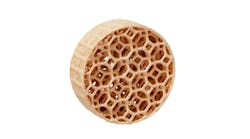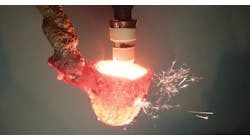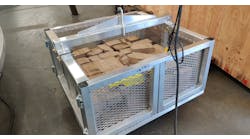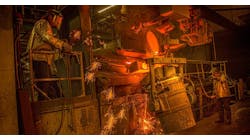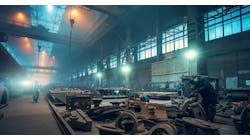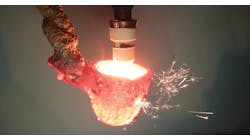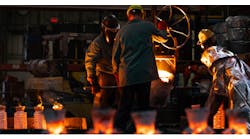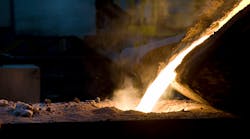In both gray iron and ductile iron metallurgy, deoxidation not only produces a cleaner iron matrix but also a material that is substantially stronger. For gray iron, Class 30 iron strength nearly reaches Class 40 strength levels, without alloying. In ductile iron, deoxidized base iron produces near 100,000 psi tensile strength without alloying.
Deoxidation is the treatment process that removes free oxygen atoms from the molten metal. Because of deoxidation the iron has fewer hardened oxide particles dispersed throughout its matrix, meaning it contains fewer “crack initiation sites.” Alloying the contaminated base iron in order to increase its strength is reduced or eliminated once deoxidation is accomplished. The adverse effect of the suspended oxide particles is avoided. The true strength of the “purer” base iron material is revealed in both gray and ductile iron.
The improved strength that deoxidation imparts to the base iron creates important savings for the iron foundry. In one cast iron application, over $400.00 per heat was saved on the first heat with deoxidation. Fine-tuning the iron composition on subsequent deoxidation heats produced an additional $70.00 per heat savings. And those savings occurred on a small sized heat of 2,500 lbs.
Many cast iron producers reduce carbon levels in the base iron when attempting to reach Class 40 iron strength levels. Carbon levels of 3.10% to 3.15% are common. The reduced carbon level makes it possible to attain Class 40 strength, but it harms the volumetric expansion provided by graphite precipitation in the iron during solidification. The lower carbon levels substantially reduce casting yield, increase risering requirements, and add to casting difficulty.
With deoxidized base iron, carbon levels can be increased to 3.30% C and alloying can be completely or nearly eliminated at the same time. The graphite portion of the overall carbon level is increased in addition to the overall level of carbon being increased in deoxidized iron.
Castability of Class 40 iron changes, becoming similar to the ease of casting Class 30 iron.
Deoxidation removes free-oxygen atoms that are always present in conventionally melted iron. That free oxygen reduces the portion of carbon precipitating as graphite in ductile and gray iron, which critically affects the volumetric shrinkage occurring during solidification.
With proper deoxidation, the need for pig iron (which promotes graphite formation in gray and ductile iron) is eliminated entirely. Pig iron has no purpose or no value or purpose to melted gray or ductile iron if that iron has been deoxidized. Foundries using Mastermelt’s DeOX Metal Treatment deoxidation process have eliminated pig iron, both the basic pig iron grade and foundry grade in gray iron and low silicon/low manganese in ductile iron, without incident or adverse effects.
Ductile iron producers typically add copper to the melt to enhance the material’s tensile strength. That becomes unnecessary when base iron is deoxidized prior to magnesium conversion treatment. The deoxidized iron’s strength rises to near 100,000 psi after deoxidation, without copper addition. Deoxidation removes the suspended MgO oxide particles that reduce strength and elongation in ductile iron.
The anneal heat-treatment that ductile iron foundries apply in order to meet the ferritic ductile iron elongation specification levels is no longer needed. As-cast elongation of deoxidized ductile iron nears 20%. And this high level of elongation is achieved without influence of residual levels of chrome or manganese.
This latter point directly confronts age-old ductile iron theories that set limits of chrome to 0.05%; above that level, carbide formation initiates. Deoxidation of ductile base iron has produced material that is carbide-free, near 20% elongation, near 100,000-psi tensile strength, in cupola melted iron containing 0.30% Cr. This never-before result was first observed in Mastermelt deoxidation trials and confirmed in additional testing, and it is being fully investigated at this time.
Ron Beyerstedt is the president of Mastermelt LLC. Contact him at [email protected]
